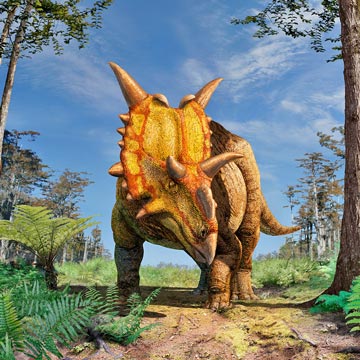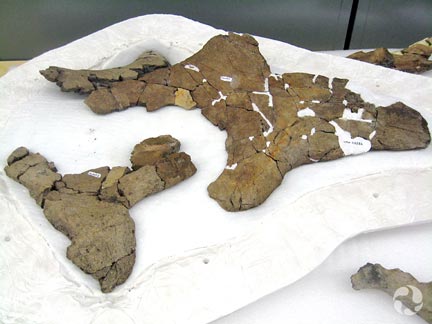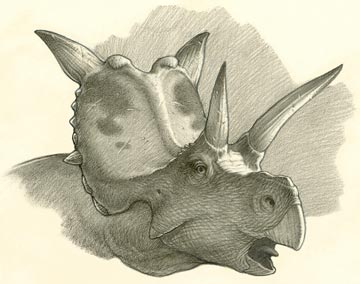Adding to Alberta’s Ceratopsian Diversity – Xenoceratops
When the ceratopsians (horned dinosaurs) are considered one point (or should that be a series of points) that comes to mind is the amazing bony neck frills of these ornithischians. Whether its the centrosaurines or the Chasmosaurinae (two main clades of ceratopsian), there seems to be no end to the strange crests, ornamentations and horns that these animals possessed. Some of these dinosaurs do indeed look almost alien in appearance. This brings us nicely to Canada’s newest centrosaurine dinosaur – Xenoceratops, as the name actually means “alien horned face”. A new horned dinosaur has been described from fossils found in Canada.
New Horned Dinosaur
Fossils found in south-western Alberta, close to the little community of Foremost just forty miles or so from the border with the United States, have proved to belong to a new species of horned dinosaur. The fossils were originally collected from the Foremost Formation of early Campanian aged sediments back in 1958 by an American palaeontologist called Dr Wann Langston Junior. These specimens remained in storage at the Canadian Museum of Nature’s research and collections facility in Gatineau, Quebec. Scientists Dr Michael Ryan (Curator of Vertebrate Palaeontology at the Cleveland Museum of Natural History) and Dr David Evans of the Royal Ontario Museum came across the fossil material over a decade ago and after examining the fragments they concluded that these were the remains of a new type of horned dinosaur.
Dr Evans went onto locate a fifty-year old burlap and plaster wrapped parcel that had been collected from the same site at the same time. These fossils were in storage at the Canadian Museum of Nature. Examining the old plaster field jacket more skull bones from the same fossil locality were identified and from the resulting study a new genus of horned dinosaur came to be named.
An Artists Illustration of Xenoceratops in Late Cretaceous Alberta
Picture credit: Julius Csotonyi
Xenoceratops foremostensis
Xenoceratops foremostensis (pronounced zee-no-sera-tops for-mose-ten-sis) was up to six metres long and would have weighed over 1,500 kilogrammes. This newly identified herbivorous dinosaur represents the oldest known large, ceratopsian dinosaur found in Canada to date. The academic paper that describes this discovery has just been published in the Canadian Journal of Earth Sciences. Authors Ryan and Evans go onto highlight the importance of this dinosaur discovery. Compared to other Late Cretaceous formations of Alberta (such as Dinosaur Provincial Park for example), the Foremost Formation has offered very little vertebrate fossil material. Microfossils and isolated teeth have been found but very few dinosaurs are known from this strata. The discovery of Xenoceratops marks a “high water mark” in terms of dinosaur discoveries from the south-western part of the province.
Some of the Fossilised Bone Fragments being Pieced Together
Picture credit: Canadian Museum of Natural History
The Foremost Formation is dated to around 80 million years ago, it is much older than the likes of the main fossil bearing sites of the Dinosaur Provincial Park, fossils found in the Foremost Formation can help palaeontologists to understand how groups of dinosaurs such as ceratopsians radiated and became more diverse.
Dr Ryan commented:
“Starting 80 million years ago, the large-bodied horned dinosaurs in North America underwent an evolutionary explosion. Xenoceratops shows us that even the geologically oldest ceratopsids had massive spikes on their head shields and that their cranial ornamentation would only become more elaborate as new species evolved.”
Bizarre Pattern of Horns
The bizarre pattern of horns on this dinosaur’s head certainly make it look like a concept from a sci-fi illustrator. A large, bony frill protruded from the back of the skull and this had two substantial horns sticking upwards. There were horns over each eye and perhaps a small nose horn as well.
An Artistic Rendering of the Face of Xenoceratops
Picture credit: Mark Schultz
Dr David Evans went onto add:
“Xenoceratops provides new information on the early evolution of ceratopsids, the group of large-bodied horned dinosaurs that includes Triceratops. The early fossil record of ceratopsids remains scant, and this discovery highlights just how much more there is to learn about the origin of this diverse group.”
This dinosaur is just the latest in a series of new finds being made by Ryan and Evans as part of their Southern Alberta Dinosaur Project, which is designed to fill in gaps in our knowledge of Late Cretaceous dinosaurs and how such diverse dinosaurs evolved. This project focuses on the palaeontology of some of the oldest dinosaur-bearing rocks in Alberta, which is less intensely studied than that of the famous badlands of Dinosaur Provincial Park and Drumheller.
Few replicas and models of Xenoceratops have been made, but recently a new range of articulated horned dinosaurs has been created that does feature a Xenoceratops.
To view this range: Beasts of the Mesozoic Articulated Dinosaur Models and Figures.
Everything Dinosaur acknowledges the contribution of the Canadian Museum of Nature (Ottowa) in the compilation of this article.









Leave A Comment